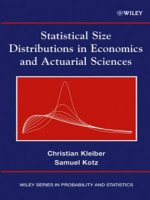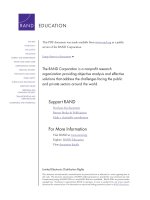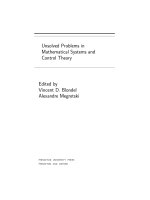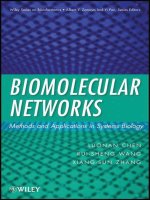Statistical significance assessment in computational systems biology
Bạn đang xem bản rút gọn của tài liệu. Xem và tải ngay bản đầy đủ của tài liệu tại đây (3.07 MB, 119 trang )
STATISTICAL SIGNIFICANCE ASSESSMENT IN
COMPUTATIONAL SYSTEMS BIOLOGY
LI JUNTAO
NATIONAL UNIVERSITY OF SINGAPORE
2012
STATISTICAL SIGNIFICANCE ASSESSMENT IN
COMPUTATIONAL SYSTEMS BIOLOGY
LI JUNTAO
(Master of Science, Beijing Normal University, China )
A THESIS SUBMITTED
FOR THE DEGREE OF DOCTOR OF PHILOSOPHY
DEPARTMENT OF STATISTICS AND APPLIED PROBABILITY
NATIONAL UNIVERSITY OF SINGAPORE
2012
DECLARATION
I hereby declare that the thesis is my original work and it has been written by
me in its entirety. I have duly acknowledged all the sources of information which
have been used in the thesis.
This thesis has also not been submitted for any degree in any university
previously.
LI JUNTAO
15 April 2012
ii
Acknowledgements
I would like to thank my supervisor Prof. Choi Kwok Pui for his guidance
on my study and his valuable advice on my research work. As a part-time PhD
student, I have encountered many difficulties in balancing my job and study. At
these moments, Prof. Choi always encouraged me to keep pursuing my goal and
showed great patience in tolerating my delay in making progress.
I would also like to thank my supervisor in Genome Institute of Singapore, Dr.
R Krishna Murthy Karuturi who is my mentor and my friend. During the past
seven years in GIS, he consistently supported me and encouraged me. I would not
have finished my PhD thesis without his advice and help.
Thanks go to my colleagues in the Genome Institute of Singapore, Paramita,
Huaien, Ian, Max and Sigrid who work together with me and share many helpful
ideas and discussions. I thank Dr. Liu Jianhua from GIS and Dr. Jeena Gupta
from NIPER, India who provided their beautiful datasets for my analysis. Spe-
iii
cially, I thank GIS and A*STAR for giving me the opportunity to pursue my PhD
study.
Last but not least, I would like to give my most heartfelt thanks to my family:
my parents, my wife and my baby. Their encouragement and support have been
my source of strength and power.
Li Juntao
January 2012
CONTENTS iv
Contents
Acknowledgements ii
Summary viii
List of Tables ix
List of Figures xi
1 Introduction 1
1.1 Overview of microarray data analysis and multiple testing 2
1.2 Error rates for multiple testing in microarray studies 4
1.3 p-value distribution and π
0
estimation 9
1.4 Significance analysis of microarrays . . 11
CONTENTS v
1.5 Problemsandapproaches 13
1.5.1 Constrained regression recalibration 17
1.5.2 Iterative piecewise linear regression 18
1.6 Organizationofthethesis 19
2 ConReg-R: Constrained regression recalibration 20
2.1 Background 20
2.2 Methods 24
2.2.1 Uniformly distributed p-valuegeneration 24
2.2.2 Constrained regression recalibration 26
2.3 Results 31
2.3.1 Dependencesimulation 31
2.3.2 Combined p-valuessimulation 37
3 iPLR: Iterative piecewise linear regression 44
3.1 Background 44
3.2 Methods 48
CONTENTS vi
3.2.1 Re-estimatingtheexpectedstatistics 49
3.2.2 Iterative piecewise linear regression 53
3.2.3 iPLRforone-sidedtest 57
3.3 Results 58
3.3.1 Two-classsimulations 58
3.3.2 Multi-classsimulations 63
4 Applications of ConReg-R and iPLR in Systems Biology 67
4.1 Yeastenvironmentalresponsedata 67
4.2 HumanRNA-seqdata 72
4.3 Fissionyeastdata 74
4.4 HumanEwingtumordata 75
4.5 Integratinganalysisintype2diabetes 79
5 Conclusions and future works 86
5.1 Conclusions 86
5.2 Limitations and future works 89
CONTENTS vii
5.2.1 Some special p-value distributions 89
5.2.2 Parametric recalibration method 91
5.2.3 Discrete p-values 91
5.2.4 π
0
estimationforConReg-RandiPLR 93
5.2.5 Other regression functions for iPLR 93
Bibliography 93
CONTENTS viii
Summary
In systems biology, high-throughput omics data, such as microarray and se-
quencing data, are generated to be analyzed. Multiple testing methods always are
employed to interpret the omics data. In multiple testing problems, false discov-
ery rates (FDR) are commonly used to assess statistical significance. Appropriate
tests are usually chosen for the underlying data sets. However the statistical sig-
nificance (p-values and error rates) may not be appropriately estimated due to the
complex data structure of the microarray.
In this thesis, we proposed two methods to improve the false discovery rate es-
timation in computational systems biology. The first method, called constrained
regression recalibration (ConReg-R), recalibrates the empirical p-values by mod-
eling their distribution in order to improve the FDR estimates. Our ConReg-R
method is based on the observation that accurately estimated p-values from true
null hypotheses follow uniform distribution and the observed distribution of p-
values is indeed a mixture of distributions of p-values from true null hypotheses
CONTENTS ix
and true alternative hypotheses. Hence, ConReg-R recalibrates the observed p-
values so that they exhibit the properties of an ideal empirical p-value distribution.
The proportion of true null hypotheses (π
0
) and FDR are estimated after the re-
calibration. ConReg-R provides an efficient way to improve the FDR estimates.
It only requires the p-values from the tests and avoids permutation of the origi-
nal test data. We demonstrate that the proposed method significantly improves
FDR estimation on several gene expression datasets obtained from microarray and
RNA-seq experiments.
The second method, called iterative piecewise linear regression (iPLR),inthe
context of SAM to re-estimate the expected statistics and FDR for both one-sided
as well as two-sided statistics based tests. We demonstrate that iPLR can accu-
rately assess the statistical significance in batch confounded microarray analysis.
It can successfully reduce the effects of batch confounding in the FDR estima-
tion and elicit the true significance of differential expression. We demonstrate the
efficacy of iPLR on both simulated as well as several real microarray datasets.
Moreover, iPLR provides a better interpretation of the linear model parameters.
LIST OF TABLES x
List of Tables
1.1 Four possible hypothesis testing outcomes. 5
2.1 Combined p-valuesmethods 39
3.1 Illustration of batch confounding. 46
3.2 Parameters used to simulate the 4 different datasets A, B, C and D. 59
3.3 Significant gene tables for dataset ABCD. 61
3.4 Parameters used to simulate the 4 different datasets MA, MB, MC
andMD. 63
3.5 Significant gene tables for Multi-class simulated dataset MA-MD. . 65
4.1 List of datasets used for ConReg-R and iPLR application. 68
4.2 Significant gene tables for yeast datasets. 75
4.3 Significant gene tables for human Ewing tumor datasets. 79
LIST OF FIGURES xi
List of Figures
1.1 Four different p-valuedensityplotexamples. 15
1.2 ThreedifferentQ-Qplotexamples. 17
2.1 Illustration of choosing k
best
using k vs. ˆπ
0
(k)plot. 30
2.2 Density histograms of dependent datasets and independent datasets. 33
2.3 Procedural steps for the independent and dependent datasets. . . . 34
2.4 Procedural steps for the independent and dependent datasets with
random dependent effect. 36
2.5 BoxplotsofFDRestimationerrors. 37
2.6 Density histograms for “Min”, “Max”, “Sqroot”, “Square” and
“Prod”datasets. 40
2.7 Procedure details for “Min”, “Max”, “Sqroot”, “Square” and “Prod”
datasets at π
0
=0.7. 41
2.8 Procedure details for “Min”, “Max”, “Sqroot”, “Square” and “Prod”
datasets at π
0
=0.9. 42
2.9 BoxplotsofFDRestimationerrors. 43
3.1 Examples for Q-Q plot slope approximation. 53
3.2 WorkflowforiPLR. 54
3.3 Illustration of first two iterations in iPLR. 56
3.4 FDRcomparisonforsimulationdatasetsA,B,CandD 62
LIST OF FIGURES xii
3.5 FDR comparison for simulation data sets MA, MB, MC and MD. . 66
4.1 p-valuedensityhistogramsfor10stressresponsedatasets. 69
4.2 Improvements in FDR estimation for yeast environmental response
datasets 71
4.3 p-value density histograms for meta-analysis (“Max”) before and
after applying ConReg-R using yeast environmental response datasets. 71
4.4 p-value density histograms for RNA-seq and Affymetrix datasets. . 73
4.5 Overlap between significantly differentially expressed genes identi-
fiedbysequencingandmicroarraytechnologies. 73
4.6 SAM plot and FDR comparison (before and after iPLR re-estimation)
forS.pombedataset. 76
4.7 Clustering of all arrays from Ewing et al. data using all the genes. 77
4.8 SAM plots and FDR comparison (before and after iPLR re-estimation)
forhumanEwingtumordataset. 78
4.9 SAM plots before and after iPLR re-estimation for 30min gene ex-
pression data for type2 diabetes and integrating cluster heat map
for gene expression and histone marks. 82
4.10 RT-PCR validation on Histone H3 acetylation, lysine 4 mono methy-
lation and lysine 9 mono methylation levels on coding regions of the
chromatin modification regulating genes. 84
5.1 Hump shape and U-shape p-valuedensityhistograms 90
5.2 p-value Density histograms from Wilcoxon test for various sample
sizes. . . 92
Chapter1: Introduction 1
Chapter 1
Introduction
In recent years, a number of novel biotechnologies have enabled biologists to read-
ily monitor genome-wide expression levels. For instance, microarray technology is
one of the most popular technologies. To analyze microarray data, many statis-
tical methods are employed and multiple hypothesis testing procedure is one of
the major approaches. In multiple hypothesis testing problem, p-values and false
discovery rates (FDR) are commonly used to assess statistical significance. In this
thesis, we develop two methods to assess the statistical significance in microarray
studies. One method is extrapolative recalibration of the empirical distribution of
p-value to improve FDR estimation. The second method is iterative piecewise lin-
ear regression to accurately assess the statistical significance in batch confounded
microarray analysis.
Chapter1: Introduction 2
1.1 Overview of microarray data analysis and
multiple testing
A common question in microarray data analysis is the identification of differentially
expressed genes, i.e., genes whose expression levels are associated with possibly
censored biological and clinical covariates and outcomes. Most microarray stud-
ies include identifying disease genes (Diao et al., 2004) or differentially expressed
genes between wild type cell and mutant cell (Chu et al., 2007a); finding differ-
ential patterns by time course microarray experiments (Chu et al., 2007b; Li et
al., 2007). Moreover, microarray technology can be applied in comparative ge-
nomic hybridization (Pollack et al., 1999), SNP (single nucleotide polymorphism)
detection (Hacia et al., 1999), Chromatin immunoprecipitation on Chip (Li et al.,
2009) and even DNA replication studies (Eshaghi et al., 2007; Li et al., 2008a).
The biological question in microarray data analysis can be restated as a multi-
ple hypothesis testing problem: simultaneous testing for each gene or each probe
in microarray, with the null hypothesis of no association between the expression
measures and the covariates.
In microarray data analysis, parametric or non-parametric tests are employed.
The two sample t-test and ANOVA (Baggerly et al., 2001; Kerr et al., 2004; Park
et al., 2003) are among the most widely used techniques in microarray studies. Al-
though the usage of their basic form, possibly without justification of their main
Chapter1: Introduction 3
assumptions, is not advisable (Jafari and Azuaje, 2006). Modifications to the stan-
dard t-test to deal with small sample size and inherent noise in gene expression
datasets include a number of t-test like statistics and a number of Bayesian frame-
work based statistics (Baldi and Long, 2001; Fox and Dimmic, 2006). In limma
(linear model for microarray data), Smyth (2004) cleverly borrowed information
from the ensemble of genes to make inference for individual gene based on the
moderate t-statistic. Some other researchers also took advantages of shared infor-
mation by examining data jointly. Efron et al. (2001) proposed a mixture model
methodology implemented via an empirical Bayes approach. Similarly, Broet et
al. (2002), Edwards et al. (2005), Do et al. (2005) used Bayesian mixture model
to identify differentially expressed genes. Although Gaussian assumptions have
dominated the field, other types of parametrical approaches can also be found in
the literature, such as Gamma distribution models (Newton et al., 2001).
Due to the uncertainty about the true underlying distribution of many gene
expression scenarios, and the difficulties to validate distributional assumptions
because of small sample sizes, non-parametric methods have been widely used as
an attractive alternative to make less stringent distributional assumptions, such
as the Wilcoxon rank-sum test (Troyanskaya et al., 2002).
Chapter1: Introduction 4
1.2 Error rates for multiple testing in microar-
ray studies
Each time a statistical test is performed, one of four outcomes occurs, depending
on whether the null hypothesis is true and whether the statistical procedure rejects
the null hypothesis (Table 1.1): the procedure rejects a true null hypothesis (i.e.
a false positive or type I error); the procedure fails to reject a true null hypothesis
(i.e. a true negative); the procedure rejects a false null hypothesis (i.e. a true
positive); or the procedure fails to reject a false null hypothesis (i.e. a false negative
or type II error).
Therefore, there is some probability that the procedure will suggest an incor-
rect inference. When only one hypothesis is to be tested, the probability of each
type of erroneous inference can be limited to tolerable levels by carefully planning
the experiment and the statistical analysis. In this simple setting, the probability
of a false positive can be limited by preselecting the p-value threshold for rejecting
the null hypothesis. The probability of a false negative can be limited by perform-
ing an experiment with adequate replications. Statistical power calculations are
performed to determine the number of replications required to achieve a desired
level of control of the probability of a false negative result (pawitan et al., 2005).
When multiple tests are performed, as in the analysis of microarray data, it is even
more critical to carefully plan the experiment and statistical analysis to reduce
Chapter1: Introduction 5
Table 1.1: Four possible hypothesis testing outcomes.
Statistical inference Fail to reject the
null hypothesis
Reject the null hy-
pothesis
Total
True null hypotheses U (True negative) V (False positive) m
0
False null hypotheses O (False negative) S (True positive) m
1
Total W R m
the occurrence of erroneous inferences.
Every multiple testing procedure uses some error rate to measure the occur-
rence of incorrect inferences. Most error rates focus on the occurrence of false
positives. Some error rates that have been used in the multiple testing are de-
scribed next.
Classical multiple testing procedures use the family-wise error rate (FWER)
control. The FWER is the probability of at least one Type I error,
FWER = Pr(V>0) = 1 − Pr(V =0), (1.1)
where V is defined in Table 1.1.
The FWER was quickly recognized as being too conservative for the analysis
of genome scale data, because in many applications, the probability that any
of thousands of statistical tests yield a false positive inference is close to 1 and
no result is deemed significant. A similar, but less stringent, error rate is the
generalized family-wise error rate (gFWER). The gFWER is the probability that
more than k of the significant findings are actually false positives.
gFWER(k)=Pr(V>k). (1.2)
Chapter1: Introduction 6
When k =0,thegFWER reduces to the usual family-wise error rate, FWER.
Recently, some procedures have been proposed to use the gFWER to measure the
occurrence of false positives (Dudoit et al., 2004).
The false discovery rate (Benjamini and Hochberg, 1995) (FDR) control is now
recognized as a very useful measure of the relative occurrence of false positives in
omics studies (Storey and Tibshirani, 2003). The FDR is the expected value of
the proportion of Type I errors among the rejected hypotheses,
FDR = E[
V
R
1
{R>0}
], (1.3)
where V and R are defined in Table 1.1. If all null hypotheses are true, all R
rejected hypotheses are false positives, hence V/R =1andFDR=FWER=
Pr(V>0). FDR-controlling procedures therefore also control the FWER in the
weak sense. In general, because V/R ≤ 1, the FDR is less than or equal to the
FWER for any given multiple testing procedure.
If we are only interested in estimating an error rate when positive findings
have occurred, then the positive false discovery rate (pFDR) (Storey, 2002) is
appropriate. It is defined as the conditional expectation of the proportion of
type I errors among the rejected hypotheses, given that at least one hypothesis is
rejected
pFDR = E[
V
R
|R>0]. (1.4)
This definition is intuitively pleasing and has a nice Bayesian interpretation.
Suppose that identical hypothesis tests are performed with independent statistic
Chapter1: Introduction 7
T and rejection region Γ. Also suppose that a null hypothesis is true with a priori
probability π
0
.Then
pFDR(Γ) =
π
0
Pr(T ∈ Γ|H =0)
Pr(T ∈ Γ)
=Pr(H =0|T ∈ Γ) (1.5)
where Pr(T ∈ Γ) = π
0
Pr(T ∈ Γ|H =0)+(1−π
0
)Pr(T ∈ Γ|H = 1). Here H is an
indicator variable where H = 1 if the alternative hypothesis is true and H =0if
the null is true. We denote Pr(H =0)byπ
0
.
The conditional false discovery rate (Tsai et al., 2003) (cFDR) is the FDR
conditional on the observed number of rejections R = r,isdefinedas
cFDR = E(V/R|R = r)=E(V |R = r)/r (1.6)
provided that r>0, and cFDR = 0, for r =0.
The cFDR is a natural measure of proportion of false positives among the r
most significant tests. Further, under Storey’s mixture model (Storey, 2002), Tsai
et al. (2003) have shown that
cFDR(α)=pFDR(α)=π
0
αm/r. (1.7)
A major criticism of FDR is that it is a cumulative measure for a set of r
most significant tests. An r
th
significance test may have an acceptable FDR only
due to it being part of the r most significant tests. To address this anomaly,
Efron et al. (2001) introduced the local false discovery rate (lFDR), a variant
of Benjamini-Hochberg’s FDR. It gives each tested null hypothesis its own false
Chapter1: Introduction 8
discovery rate. While the FDR is defined for one rejection region, the lFDR is
defined for a particular value of the test statistic. The definition of lFDR is:
lFDR(t)=Pr(H =0|T = t). (1.8)
The local nature of the lFDR is an advantage for interpreting results from
individual test statistic. Moreover, lFDR is the average of global FDR given
T ∈ Γ i.e.
FDR(Γ) = E(lFDR(T )|T ∈ Γ). (1.9)
In recent years, many methods are develpoed to estimate lFDR. For example,
constrained polynomial regression procedure (Dalmasso et al., 2007), unified ap-
proach (Strimmer, 2008) or semi-parametric kernel-based approach ( Guedj et al.,
2009).
Ploner et al. (2006) generalized the local FDR as a function of multiple statis-
tics, which combining a common test statistics with its standard error information
and proposed 2D-lFDR. If two different statistics Z
1
and Z
2
capture different as-
pects of the information contained in the data, the 2D-lFDR can be defined as
2D-lFDR(z
1
,z
2
)=π
0
f
0
(z
1
,z
2
)
f(z
1
,z
2
)
, (1.10)
where f(z) is the density function of the statistics z,andf
0
(z)=f(z|z ∈ H
0
).
2D-lFDR is very useful to deal with small standard error problems.
The FDR, cFDR, pFDR, lFDR and 2D-lFDR are reasonable error rates be-
cause they can naturally be translated into the costs of attempting to validate
Chapter1: Introduction 9
false positive results. In practice the first three concepts lead to similar values,
and most statistical software will usually report only one of the three (Li et al.,
2012b).
1.3 p-value distribution and π
0
estimation
P -value is the smallest level of significance where the hypothesis is rejected with
probability one (Lehmann and Romano, 2005) and the definition is following,
Definition 1. Suppose X has distribution P
θ
for some θ ∈ Ω, and the null hy-
pothesis H
0
specifies θ ∈ Ω
H
0
. Assume the rejection regions S
α
are nested in the
sense that
S
α
⊂ S
α
if α<α
, (1.11)
p-value is defined as follows:
p = p(X) = inf{α : X ∈ S
α
}. (1.12)
A general property of p-values is given in the following lemma.
Lemma 1.1. Suppose the p-value p follows the definition 1 , and assume the
rejection regions S
α
satisfy (1.11).
(i) If
sup
θ∈Ω
H
0
P
θ
{X ∈ S
α
}≤α for all 0 <α<1, (1.13)
Chapter1: Introduction 10
then the distribution of p under θ ∈ Ω
H
0
satisfies
P
θ
{p ≤ u}≤u for all 0 ≤ u ≤ 1. (1.14)
(ii)If, for θ ∈ Ω
H
0
,
P
θ
{X ∈ S
α
} = α for all 0 <α<1, (1.15)
then
P
θ
{p ≤ u} = u for all 0 ≤ u ≤ 1; (1.16)
i.e. p is uniformly distributed over (0, 1).
Proof. (i)If θ ∈ Ω
H
0
, then the event {p ≤ u} implies {X ∈ S
v
} for all u<v.
The result follows by letting v → u.
(ii) Since the event {X ∈ S
u
} implies {p ≤ u}, it follows that
P
θ
{p ≤ u}≥P
θ
{X ∈ S
u
}.
Therefore, if (1.15) holds, then P
θ
{p ≤ u}≥u, and the result follows from (i).
From Lemma 1.1, p-values from multiple testing is assumed to follow a mixture
model with two components, one component follows a uniform distribution on
[0,1] under the null hypotheses (Casella and Berger, 2001), and other component
under the true alternative hypotheses (Pounds and Morris, 2003). A density plot
(or histogram) of p-values is a useful tool for determining when problems are
Chapter1: Introduction 11
present in the analysis. This simple graphical assessment can indicate when crucial
assumptions of the methods operating on p-values have been radically violated
(Pounds, 2006).
Additionally, it can be helpful to add a horizontal reference line to the p-
value density plot at the value of the estimated π
0
, null proportion. A line falling
far below the height of the shortest bar suggests that the estimate of the null
proportion may be downward biased. Conversely, a line high above the top of the
shortest bar may suggest that the method is overly conservative. It is appropriate
to add this line to the density plot to assess the reliability of the π
0
estimates
(Storey, 2002).
Furthermore, adding the estimated density curves to the p-value histogram can
aid in assessing model fit (Pounds and Cheng, 2004). Large discrepancies between
the density of the fitted model and the histogram indicate a lack of fit. This
diagnostic can identify when some methods produce unreliable results. This is a
good graphic diagnostic for any of the smoothing based and model-based methods
that operate on p-values.
1.4 Significance analysis of microarrays
SAM (Significance Analysis of Microarrays) is a statistical technique for finding
significant genes in a set of microarray experiments. It was proposed by (Tusher









